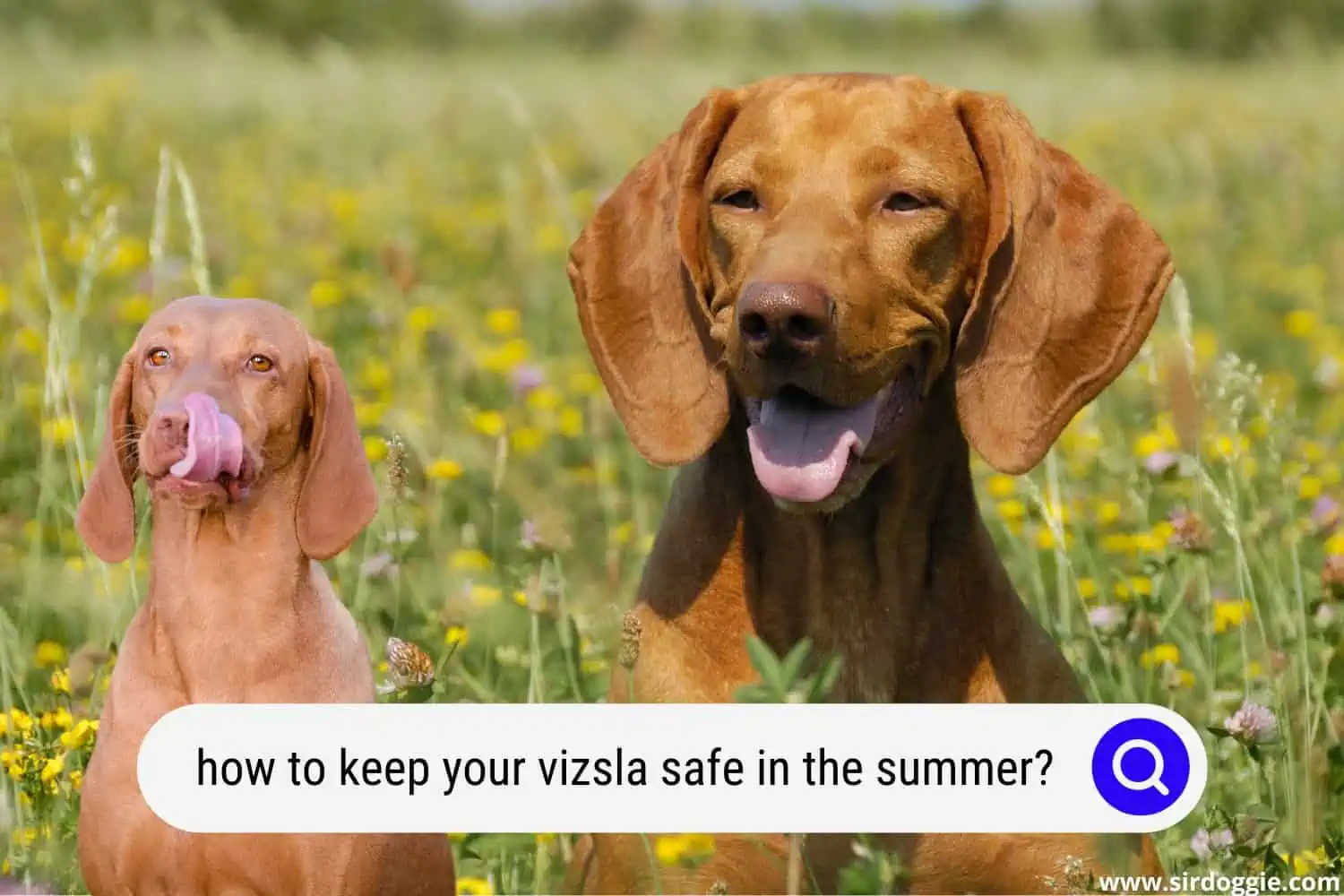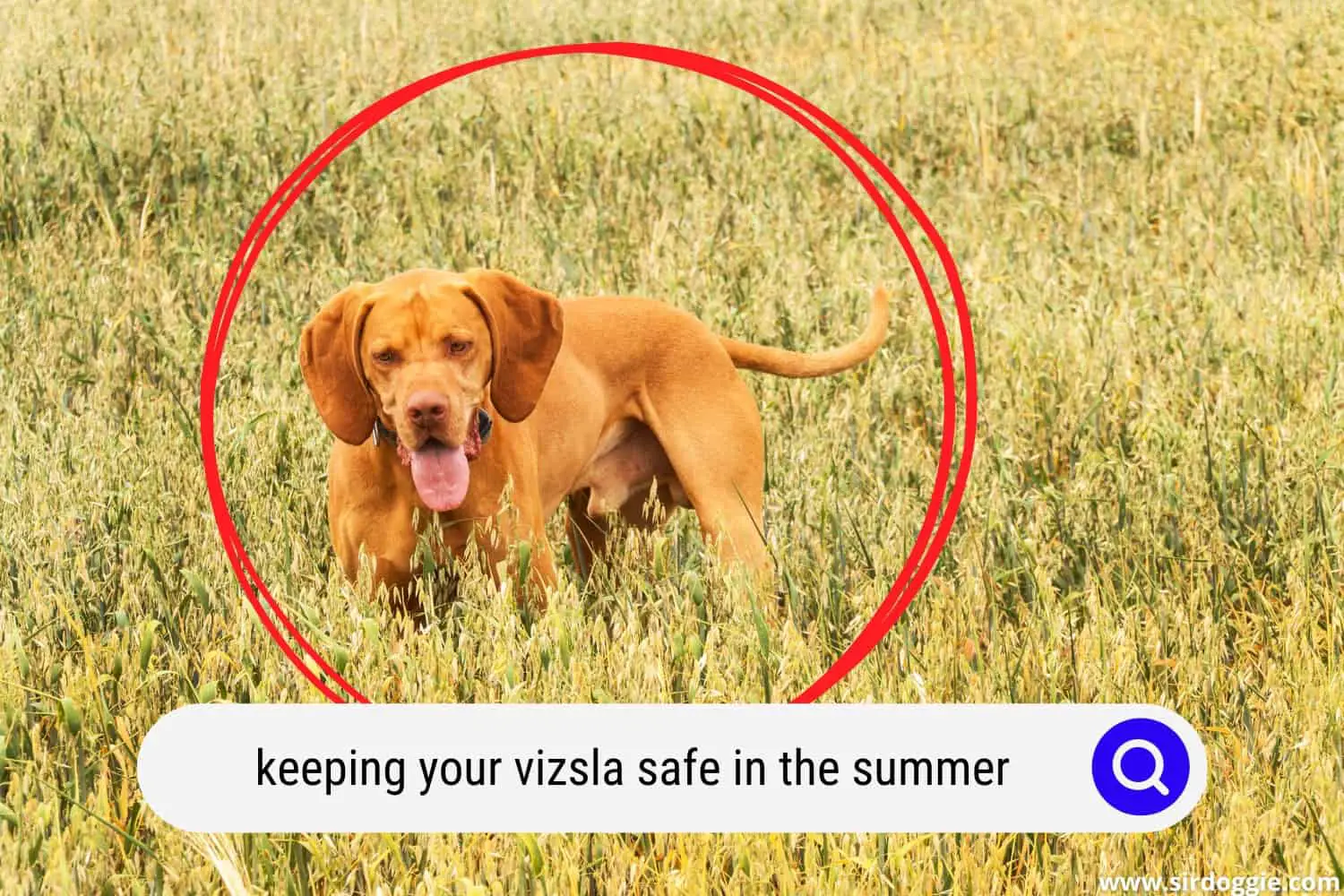How to Keep Your Vizsla Safe in the Summer?
When the summer season arrives, you will surely love to go out with your pet to the beach or the countryside. Summer is an incredible time to have fun with your Vizsla dog, especially since these canines are extremely athletic and love to go for walks and run around the area without anyone stopping them.

However, there are many aspects that cannot be ignored when it comes time to take your Vizsla out of the house in the summer.
Hot weather can also make us uncomfortable and can pose special risks to dogs. Some of them are exposure to ticks and other insects, sunburn, and heatstroke. All these kinds of things can go wrong for your Vizsla dog in the summer.
What Should I Do to Keep My Vizsla Dog Safe in the Summer?
Vaccinations
Make sure your dog’s vaccinations are up to date, especially since these animals tend to stay outdoors longer and come into contact with other animals during the summer months.
Protect It from Chemicals and Toxic Agents
Do not allow your Vizsla dog to go near lawns that have been chemically treated or fertilized in the last 24 hours. Also, keep it away from toxic plants and flowers.
Hygiene
Keep your pet well-brushed and clean. Make sure to bathe it only when necessary.
Medical Prevention
Consult your Vizsla’s vet for an effective preventative against fleas, ticks, and mosquitoes that carry heartworms.
Keep It Under the Shade
Give your Vizsla dog a shady spot to hang out on hot days or leave it indoors where there is air conditioning.
Dog kennels are not good shelters in the summer because they can trap heat. Even if you go to the beach, it is recommended that you place an umbrella or a tent so that your Vizsla can rest in the shade.
Refresh It with Water
It’s a good idea to fill a wading pool with fresh water so your pet can cool off. Do not wet your canine directly with a hose, as that can annoy it.
Roll down the Car Windows or Turn on the Air Conditioning
Never lock your Vizsla in your vehicle on a hot day. The temperature inside a car can reach 50 degrees in just 20 minutes.
We recommend that you roll down the car windows so that the canine gets fresh air, or you can turn on the air conditioning to cause a greater cooling effect.
Always Fill Its Dog Container with Plenty of Water
Provide your Vizsla with plenty of fresh, clean water. Dogs of this breed tend to run and play very often, so it is important that they stay hydrated.
Don’t Let It Exercise on Hot Days
Avoid exercising your Vizsla dog vigorously on very sunny and hot days. You can walk your pet in the morning or at night when the sun’s heat is less intense.
Don’t Walk with Your Pet in Hot Places
Avoid exposing your canine to hot asphalt or sand for a long period, as this can burn its paws.
Use Sunscreen
Protect your Vizsla from sunburn. Dogs, especially those with short hair, can get sunburned.
Limit your faithful companion’s exposure during the day and apply sunscreen to their ears, nose, and fur before heading out to the beach or for a walk.
If You Go to the Beach, Research About the Subject
Check with a lifeguard for water conditions. Dogs are easy targets for sea lice and jellyfish.
Don’t Let It Drink Salt Water on the Beach
Don’t let your Vizsla dog drink seawater. Sea salt can make your pet sick.
If You Come Back from the Beach, Bathe It
Rinse your Vizsla at the end of the day. Salt and other minerals in ocean water can damage your dog’s coat.
How Do I Protect My Vizsla Dog from the Heat while on Vacation?
If you are transported by air:
- Place ice bags wrapped in a towel or ice blanket in your Vizsla’s cage. Two-liter soda bottles filled with water and then frozen work well.
- Provide a container with fresh water, as well as another with frozen water that will thaw during the trip.
If you transport yourself by land:
- Use a cooling pad as a bed or box liner.
- Keep your dog cool in the car. If you put ice bags wrapped in a towel in its cage, you can cool down your dog. Make sure the box is well-ventilated.
- Put an umbrella on the windows of your car, at least on the side where your Vizsla is.
- Bring fresh water, a bowl, and a tent with you so that you can set up a shady spot. It is a good idea to spray cold water on your dog to cool it down.
If you travel in an RV (Recreational Vehicle):
- Never leave an RV completely closed, even with the generator and air conditioning running. Open a window or door or simply turn on the exhaust fan.
- Do not neglect the health conditions of your Vizsla. Beware of dehydration and heatstroke.
Dehydration
Vizslas can become dehydrated when more fluids come out of their bodies than they ingest. They lose fluids by panting, urinating, and even evaporation through their paws.
Some symptoms are:
- Panting.
- Dry gums and nose.
- Thick saliva.
- Lethargy.
- Hollow eyes.
- Loss of elasticity in the skin.
If you notice any of the symptoms mentioned above, the dog will need immediate rehydration and electrolyte replacement.

Heatstroke
Heatstroke can be very dangerous for dogs, especially for canines with little hair, as is the case with Vizslas. Exposure to excessive heat is fatal to all dogs in the world.
Heatstroke generally occurs when high ambient temperatures exceed the dog’s ability to dissipate heat.
Below you will be able to know the signs of heatstroke that your Vizsla can present:
First stages:
- Heavy panting.
- Fast breathing.
- Excessive drooling.
- Bright red gums and tongue.
- Difficulty keeping balance.
Advanced stages:
- White or blue gums.
- Lethargy (unwillingness to move).
- Uncontrollable urination or defecation.
- Noisy and labored breathing.
- Shock.

Family Dog Expert Author
Hi there! I’m Stuart, a devoted dog lover and family dog expert with over a decade of experience working with our furry companions. My passion for dogs drives me to share my knowledge and expertise, helping families build strong, loving bonds with their four-legged friends. When I’m not writing for SirDoggie, you’ll find me hiking, playing with my beautiful dog, or studying music.